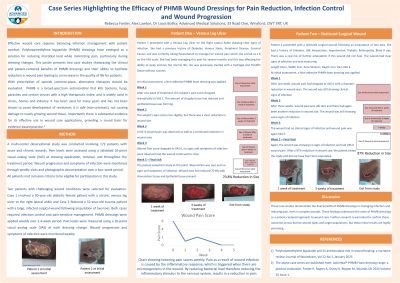Case Series/Study
(CS-043) Case Series Highlighting the Efficacy of PHMB Wound Dressings for Pain Reduction, Infection Control and Wound Progression
Friday, May 2, 2025
7:45 PM - 8:45 PM East Coast USA Time

Alex Lawton, MMATH – Advanced Medical Solutions
Introduction: Effective wound care requires balancing infection management with patient comfort. Polyhexamethylene biguanide (PHMB) dressings have emerged as a solution for reducing microbial load while minimizing pain, particularly during dressing changes. This abstract presents two case studies showcasing the clinical and patient-centered benefits of PHMB dressings.
Methods: Two patients with challenging wound conditions were selected for evaluation. Case 1 involved a 50-year-old diabetic female patient with a chronic venous leg ulcer to the right lateral ankle and Case 2 featured a 52-year-old trauma patient with a large, infected surgical wound following amputation of two toes. Both cases required infection control and pain-sensitive management. PHMB dressings were applied weekly over a 4-week period. Pain levels were measured using a 10-point visual analog scale (VAS) at each dressing change. Wound progression and symptoms of infection were monitored weekly.
Results: Case 1: The patient reported a dramatic reduction in pain, with VAS scores decreasing from 6 at baseline to 1 by week 2. By week 6, the wound area had reduced by 71%, and the patient was not showing signs and symptoms of infection.
Case 2: Pain scores dropped from 3 at baseline to 0 by week 1, with the patient describing dressing changes as "painless". The wound achieved 97% closure by week 6, with significant reductions in redness and exudate and a promotion of epithelial tissue.
Discussion: These case studies demonstrate the dual benefits of PHMB dressings in managing infection and reducing pain, even in complex wounds. These findings underscore the value of PHMB dressings as a patient-centered approach to wound care. Further research is warranted to confirm these outcomes across diverse wound types and larger populations, but these initial results are highly promising.
Methods: Two patients with challenging wound conditions were selected for evaluation. Case 1 involved a 50-year-old diabetic female patient with a chronic venous leg ulcer to the right lateral ankle and Case 2 featured a 52-year-old trauma patient with a large, infected surgical wound following amputation of two toes. Both cases required infection control and pain-sensitive management. PHMB dressings were applied weekly over a 4-week period. Pain levels were measured using a 10-point visual analog scale (VAS) at each dressing change. Wound progression and symptoms of infection were monitored weekly.
Results: Case 1: The patient reported a dramatic reduction in pain, with VAS scores decreasing from 6 at baseline to 1 by week 2. By week 6, the wound area had reduced by 71%, and the patient was not showing signs and symptoms of infection.
Case 2: Pain scores dropped from 3 at baseline to 0 by week 1, with the patient describing dressing changes as "painless". The wound achieved 97% closure by week 6, with significant reductions in redness and exudate and a promotion of epithelial tissue.
Discussion: These case studies demonstrate the dual benefits of PHMB dressings in managing infection and reducing pain, even in complex wounds. These findings underscore the value of PHMB dressings as a patient-centered approach to wound care. Further research is warranted to confirm these outcomes across diverse wound types and larger populations, but these initial results are highly promising.

.jpg)